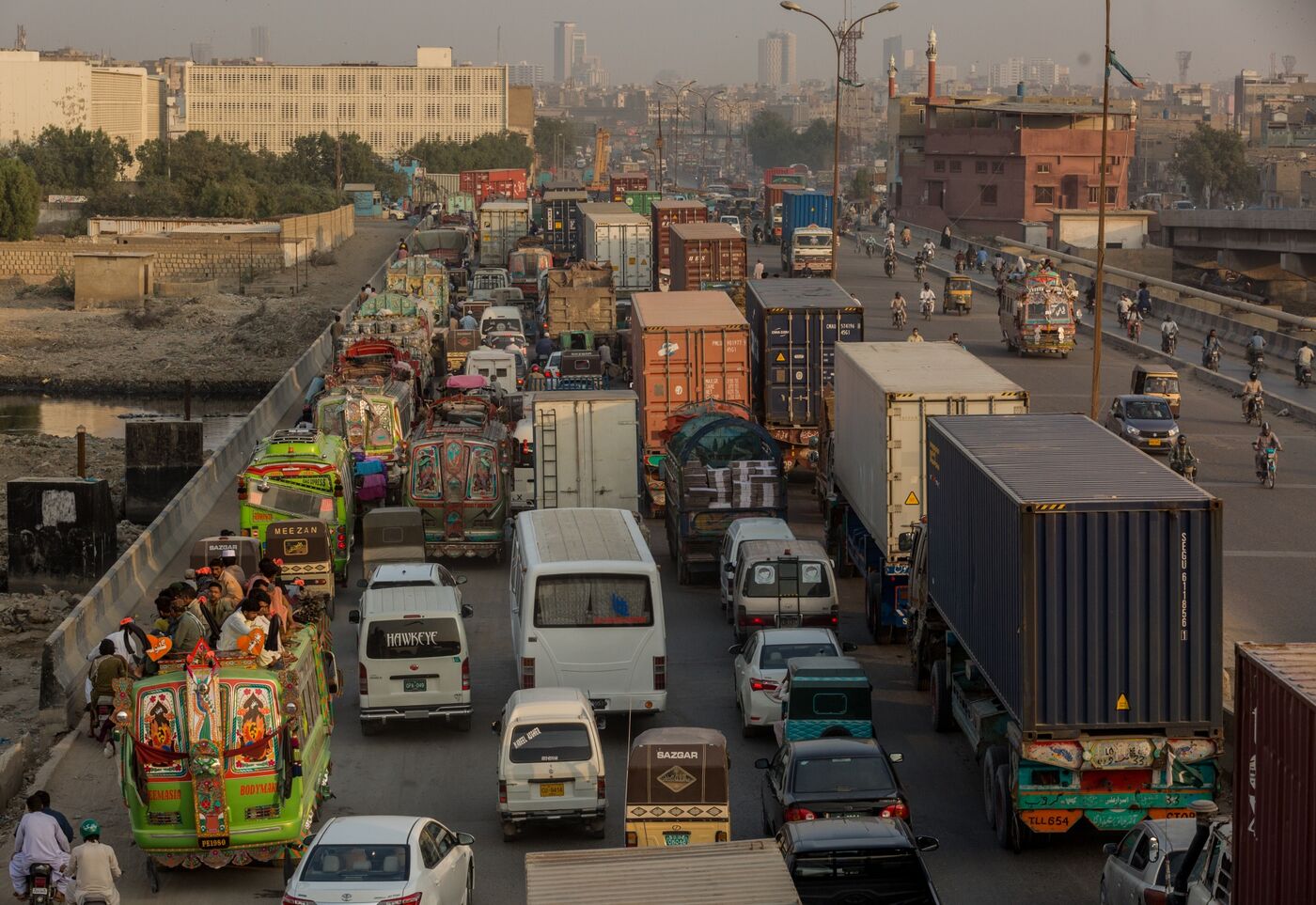The World's Worst Public Transport System Attempts to Modernize
Incomplete roads in Karachi — the biggest city in Pakistan and the third-largest in the world — show what happens when a megacity becomes a political orphan.
Muhammad Ali Jinnah Road has always had its share of traffic, but lately the main thoroughfare that connects central Karachi to its major port is in a state of near constant gridlock.
An elevated street eats up two of the road’s three lanes, but it’s empty — part of an incomplete project to create express lanes for public buses that was supposed to finish three years ago. It’s one of many towering structures scattered throughout the Pakistani city that were part of the latest plans to bring a modern transportation to Karachi, one of the world’s fastest-growing cities and the third-biggest by population.
Karachi ranks as having the worst public transport system globally, according to a 2019 study by car-parts company Mister Auto that looked at 100 major cities. It serves about 42% of Karachi’s commuters, relying on decades-old, overcrowded buses that use the roof as a second deck for passengers at times. Roads are filled with potholes, not all traffic signals are automated, and it’s common to see drivers running red lights. And yet the former capital is home to Pakistan’s main ports and the regional headquarters for companies such as Standard Chartered Plc and Unilever Plc, helping it generate half of the nation’s tax revenue.

Karachi ranks as having the worst public transport system globally, according to a study by Mister Auto that looked at 100 major cities.
Photographer: Asim Hafeez/Bloomberg
Those funds, however, get distributed to other parts of the country. The city’s outgoing mayor Waseem Akhtar said last year he had only 12% administrative control of the city and a lack of funds. The army controls the wealthier areas of Karachi, while the rest is divided among the provincial and federal governments that don’t get along.
“Karachi, despite its importance, is a political orphan,” said Arsalan Ali Faheem, a consultant at DAI, a Bethesda, Maryland-based company that advises on development projects. “The federal government is limited in what it can do, and the city government controls less than a quarter of the city. It means that Karachi’s problems belong simultaneously to everyone and no one.”
The dysfunction came into focus in August when record rainfall flooded many parts of the city for more than a week. About 64 people died while 10,000 had to be rescued. The flooding left many people trapped and without electricity that was suspended. A few days later, mobile phone service and cash machines stopped working too.

Telephone and electricity cables on I.I. Chundrigar Road. Karachi is one of the world’s fastest-growing cities and the third-biggest by population.
Photographer: Asim Hafeez/Bloomberg
In its aftermath, Pakistan Prime Minister Imran Khan visited the city and announced a development package valued at 1.1 trillion rupees ($6.8 billion) jointly with the provincial government including the bus project and a circular railway system. The amount is more than $6 billion loan bailout Pakistan agreed from the International Monetary Fund to avoid bankruptcy.
Accessing those funds has been a different story. The provincial government’s transport department has admitted it can’t do large projects on its own. Khan’s federal government announced 162 billion rupees for mega projects in the city last year including transport, but city officials reported that no funds were ever released earlier this year. The federal government said in response that it has spent 24.65 billion rupees up to June, while an allocation of 17.9 billion rupees has been made for the current fiscal year.
The latest attempts follows several others to bring Karachi’s transportation system into the modern era. Multiple bus projects have been announced over the years but either they never started or were unable to sustain for more than a few years. Meanwhile, Lahore in eastern Pakistan started a train service last week after getting a similar bus project running seven years ago.

Lines of Karachi Transport Corp. buses. In the absence of the former railway, colorful old buses have taken over as the main public transport system.
Photographer: Asim Hafeez/Bloomberg
Karachi was once well connected by a circular railway but corruption and mismanagement in the transportation sector brought the city to a grinding halt in the late 1990s, according to Adam Weinstein, research fellow at the Washington D.C.-based Quincy Institute for Responsible Statecraft. Many of the railway tracks have become illegal slums with people moving from smaller towns to earn more.
“Karachi has yet to find a humane way to address land encroachment that stymies development and relocate people without incurring immense political blowback,” said Weinstein.
The green line bus project was announced six years ago. It’s now expected to be completed around June of next year, said Asad Umar, Pakistan's federal planning minister and part of a Karachi committee to oversee the city's large projects. Following delays, the bus project has been progressing since the federal government took it over earlier this year, he said. Pakistan's provincial Sindh government spokesperson Murtaza Wahab didn’t respond to requests for a comment.

Rubbish is strewn across disused tracks of the circular railway line. Many of the Karachi’s railway tracks have become part of illegal slums.
Photographer: Asim Hafeez/Bloomberg
The delays are hardly an anomaly. The circular railway revival has been discussed for at least 15 years, while a water supply project is 18 years in the making. The city’s most expensive area doesn’t have access to piped water and relies on water supplied through tankers, also known as “tanker mafia.”
“If cities can provide quality infrastructure, it by default increases productivity,” Uzair Younus, a non-resident senior fellow at the Atlantic Council, said by phone. He’s the host of the “Pakistonomy” podcast and a former Karachi resident. “An administrative setup that is unable to provide decent mass transit to the largest city in the country will always be viewed with skepticism.”
Bloomberg - Are you a robot?
www.bloomberg.com

